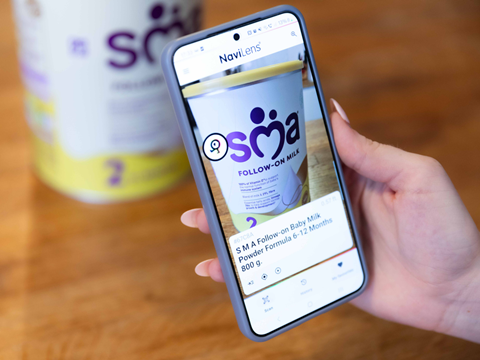
SMA Nutrition is aiming to support its visually impaired consumers by putting NaviLens codes on all its product packaging, with the technology enabling visually impaired parents and caregivers to make informed purchasing decisions and get answers to feeding queries, in-store and at home.
Said to be a ‘world first’, SMA says that blind and partially sighted parents and caregivers can now use NaviLens on all its formula packs, giving them a higher level of independence when making choices regarding their children’s feeding. Scannable codes, similar to QR codes, have been integrated into all SMA packaging.
When a visually impaired shopper points their device towards the SMA product, their smartphone can detect the on-pack code from up to three metres away. The company says this triggers their phone, and the customer can choose to access all product information including the ingredients, allergens, and recycling information read aloud in their phone’s language, or view it on their device using accessibility tools.
The technology is free to use. Consumers are required to download the NaviLens or NaviLens GO apps, which are compatible with all smartphones. At home, it is expected that visually impaired parents and families will able to use the NaviLens app to read aloud preparation instructions for SMA products; provide step-by-step guidance on measuring formula and ensuring proper preparation; and offer additional resources on safe formula feeding practices.
The NaviLens app apparently has up to 37 languages available, providing translation support and hoping to make formula preparation instructions accessible regardless of the user’s native language. Sighted parents who are preparing night feeds and need someone to read preparation instructions in the early hours can also benefit.
Vicky Woods, managing director of Nestlé Nutrition UK and Ireland, said that Nestlé has worked with the NaviLens team to customize the user experience to be suitable for this category. She adds: “We are also grateful for the support of the Royal National Institute of Blind People (RNIB), whose advice has been invaluable in adopting this technology across our portfolio.”
John Worsfold, head of Solutions Innovation at RNIB, commented: “Blind and partially sighted parents should have the same freedom, independence and choice as sighted customers when it comes to buying products and accessing on-pack information. Currently, important information on packaging can often be in very small print, making it difficult or impossible for people with sight loss to read.
“Technology such as NaviLens is a game changer and allows blind and partially sighted people to independently identify and access key information on packaging. This is why we’re so pleased to collaborate with brands such as SMA Nutrition on our ongoing mission to highlight how the industry can raise its game and make packaging more accessible.”
In January, Roland DG revealed it had commissioned a study revealing the negative impact of inaccessible on-pack product information on visually impaired consumers, and encouraged brands to embrace Braille, QR codes, and other solutions to ensure complete inclusivity. The study revealed that 74% of UK adults with visual impairment surveyed have picked up the wrong product whilst shopping due to inadequate packaging guidance, and 81% believe legal mandates should be introduced to force brands to improve the accessibility of their products and ensure that on-pack product information is available for all to read, regardless of their vision.
In the same month, Unilever partnered with Be My Eyes to expand its use of Zappar’s Accessible QR (AQR) technology to provide AI-powered virtual assistance for blind and visually impaired consumers via a free app. A dot-dash pattern is applied around one corner of the AQR code, which makes them detectable through accessibility apps from 1.1 metres away – over seven times the distance available through conventional QR scanning.
If you liked this story, you might also enjoy:
How are the top brands progressing on packaging sustainability?
Sustainable Innovation Report 2024: Current trends and future priorities
Reuse vs. single use – which is better for the environment?
The ultimate guide to global plastic sustainability regulation


















No comments yet